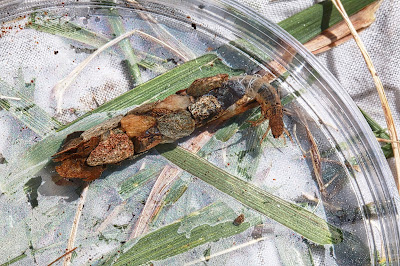We continue to look for Soyedina Nemourids: so far no luck. The nymph that I found on 3/9 is one that's as yet "undescribed": it's either a new species of Soyedina or, what's more likely, one that has not yet been associated with an adult. Steve Beaty wants us to send down more specimens -- so the search will go on.
In the meantime, I've been back to Sugar Hollow a number of times where we're finding numerous insects, including this spectacular flatheaded mayfly, Maccaffertium meririvulanum. As we've noted before, M. meririvulanum and M. pudicum co-occur in pristine, headwater streams. They're both fairly big nymphs (meririvulanum, 10-16 mm; pudicum, 11-14 mm) and look a lot alike -- but we can tell them apart.
While the ventral pattern is crucial for identifying almost all of the the Macs, the dorsal view suffices with meririvulanum. The "V's" give it away. Reading from Beaty ("The Ephemeroptera of North Carolina, p. 34): "...terga 5 and either 7-8, or 7-9 each with distinct V-shaped pale mark." On our nymph they're easy to see on terga 5, 7, and 8.
In his descripton he adds: "ventrally pale." True.
M. meririvulanum is one of the least tolerant species in the genus: TV of 0.5.
___________________
To identify M. pudicum, it's best to go right to the venter, though I do find the orange/pale pattern on segment 7 to be a fairly consistent indication of species.
The venter can have 1 of 2 patterns. On this nymph this is the venter we see.
_________________
Some of the other things we've been seeing.
1) Perlodid stonefly, Isoperla similis/pseudosimilis Groups (a young one)
2) Leuctridae (Rolled-wing stonefly), genus Leuctra
3) and a very pretty Northern Case-maker, Pycnopsyche gentilis.











No comments:
Post a Comment